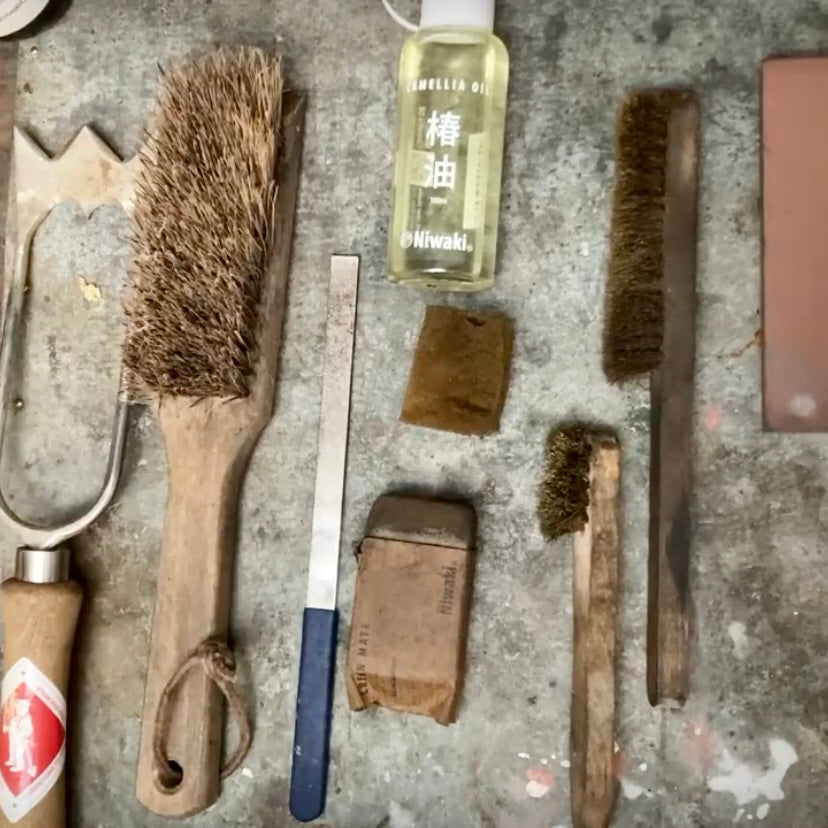
Maintain your garden tools this Spring...
Share

Quality garden tools – including spades, trowels and hoes from Sneebeor or Niwaki - will have a bevelled edge which allows you to cut through the soil more easily when you are digging and planting. The bevel will, however, wear off over time due to continued use - especially if you’re in heavy soil or if it’s coming into contact with stones regularly.
With just a little bit of regular maintenance, you can keep your tools working as they were designed, and to help make your life a little easier whilst gardening.
What do you need?
You can build up your own garden tool maintenance set that can be used with small hand tools (e.g. standard trowels and the Japanese Hori-Hori) as well as larger gardening tools (e.g. spades and hoes). To be able to clean tools, remove any rust and re-edge them, your maintenance kit should ideally include:
- To clean: A stiff gardening brush, wire brushes, and Niwaki Crean Mate (which needs soaking in water).
- To sharpen: Diamond sharpening file (which can be used dry), Niwaki 1000 grit sharpening stone (which needs to be soaked for 5 minutes prior to using) and if you have any tools with a curved bevel, a rat’s tail file (a thin round file which looks like a rat’s tail– which you can run along curved edges.)
- To protect: Camelia oil (or a light machine oil) for the metal surface, boiled linseed oil for handles, and either sponges or cloths (ideally lint free) to apply.
Or you buy a complete set, like the Sneeboer Maintenance Kit (which includes linseed oil, a special sharpener, and wire brush) which comes in a lovely box (making it a great gift). Or we offer two kits that can be combined that will cover most of your gardening tool maintenance needs: the Secateur Maintenance Kit and the Garden Tool Maintenance Kit.
How to maintain your garden tools:
- Clean the tools first so you can clearly see the surface of the tool and particularly what state the bevel edge is in. If the tools are stainless steel, you can just use a stiff gardening brush to remove any dirt and mud. If your tools aren’t stainless steel and you have some surface rust, you will need to use a wire brush to clean them up. Niwaki Crean Mate is particularly good for cleaning up tools that are carbon steel.
- To sharpen: File your edge back in. Just lay your file onto the angle of the bevel and follow this angle by working the file gently up and down. You aren’t looking to create a knife edge, just to put the bevel back in to the tool. Most garden tools have a bevel on just one side (they are single bevelled) meaning you only have to work your file in this one direction (a kitchen knife or penknife has a bevel on both sides, so you have to file each side). To check if you’re happy with the sharpened edge, just carefully run your figure over the bevel to feel that it’s sharp – if not, keep filing until you are happy. Once done, turn your tool over and just smooth over the backside of the tool – to take off any material that you’ve filled which has fallen around the edges.
- To protect: Camelia Oil is a natural oil that’s perfect for lightly wiping over your garden tools to give them some protection. Linseed oil can then be wiped over the wooden handles to re-moisturise them and stop them from cracking from sun damage. Both can be simply wiped on with a sponge or cloth.
If you can get into a Tinker and Fix Maintenance Mindset you’ll have your garden tools for life (if you’ve bought good quality ones to begin with!) Cleaning them off after each use, before you put them away, makes a big difference and means that your regular maintenance checks become less arduous.
